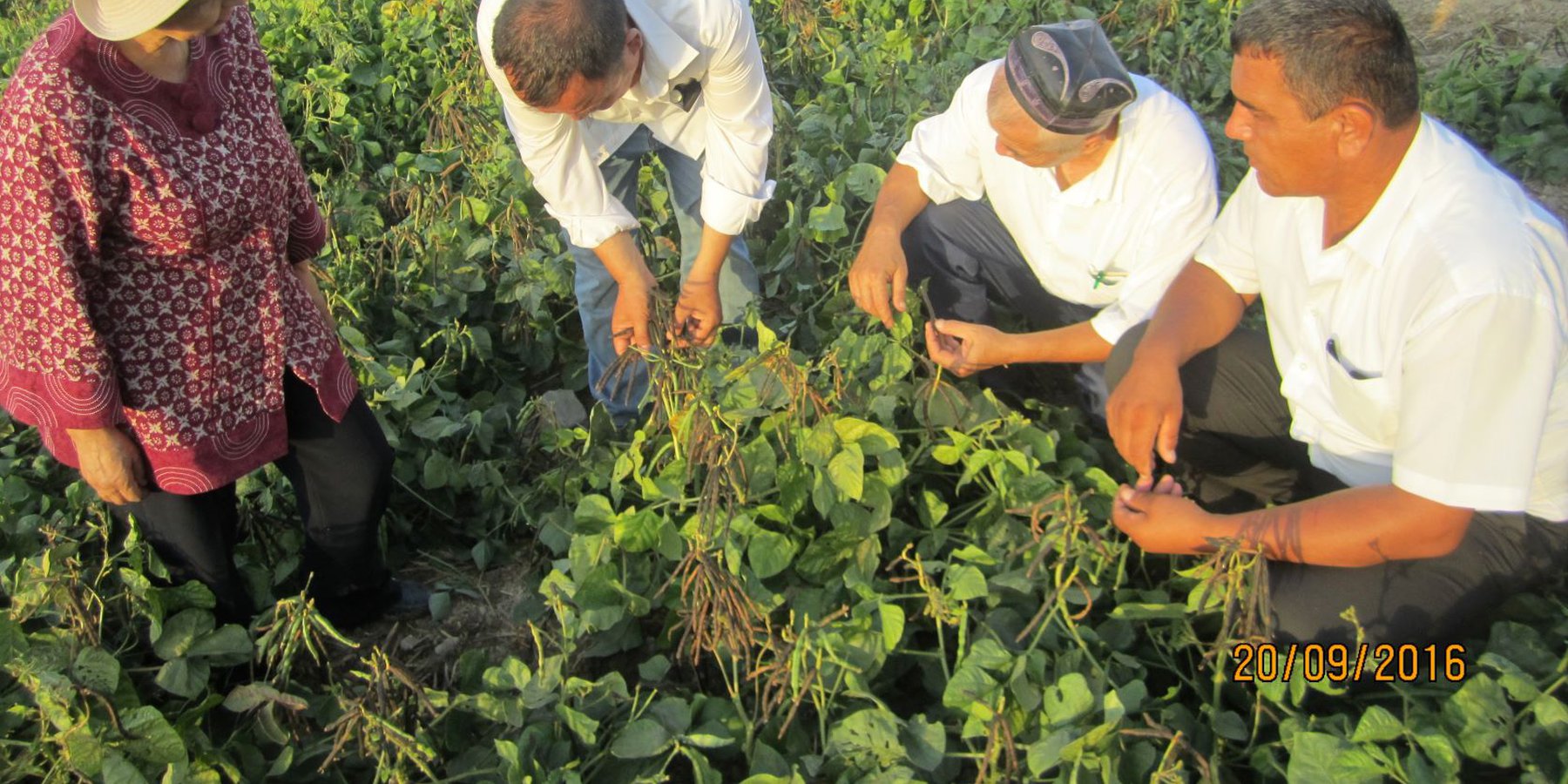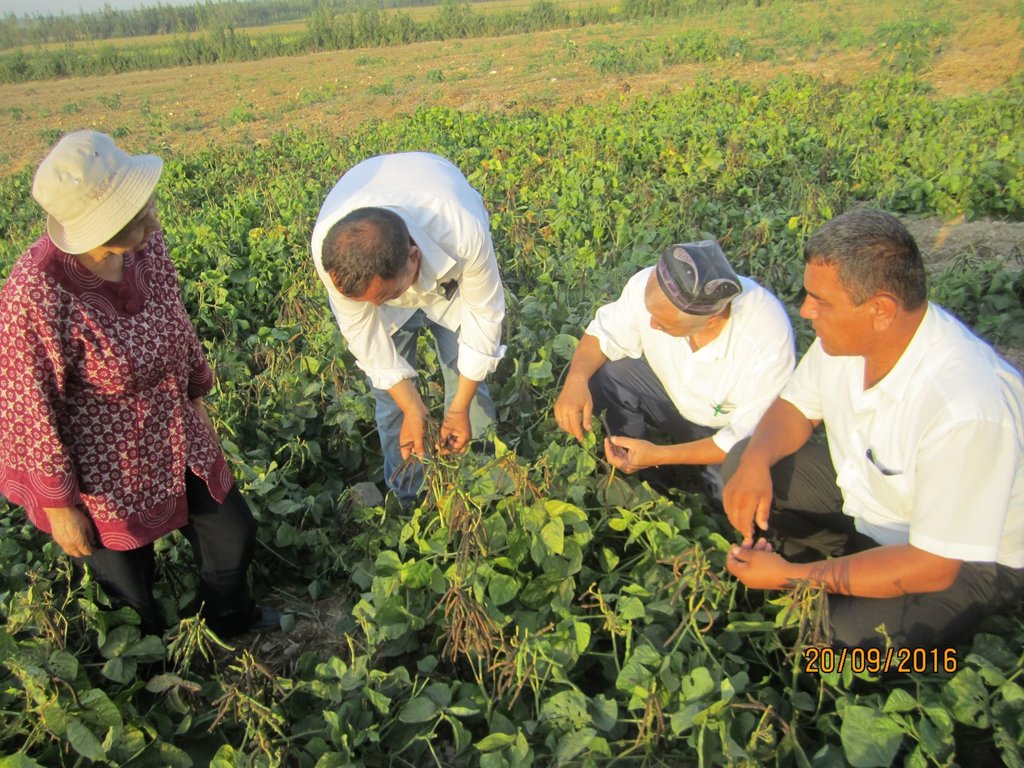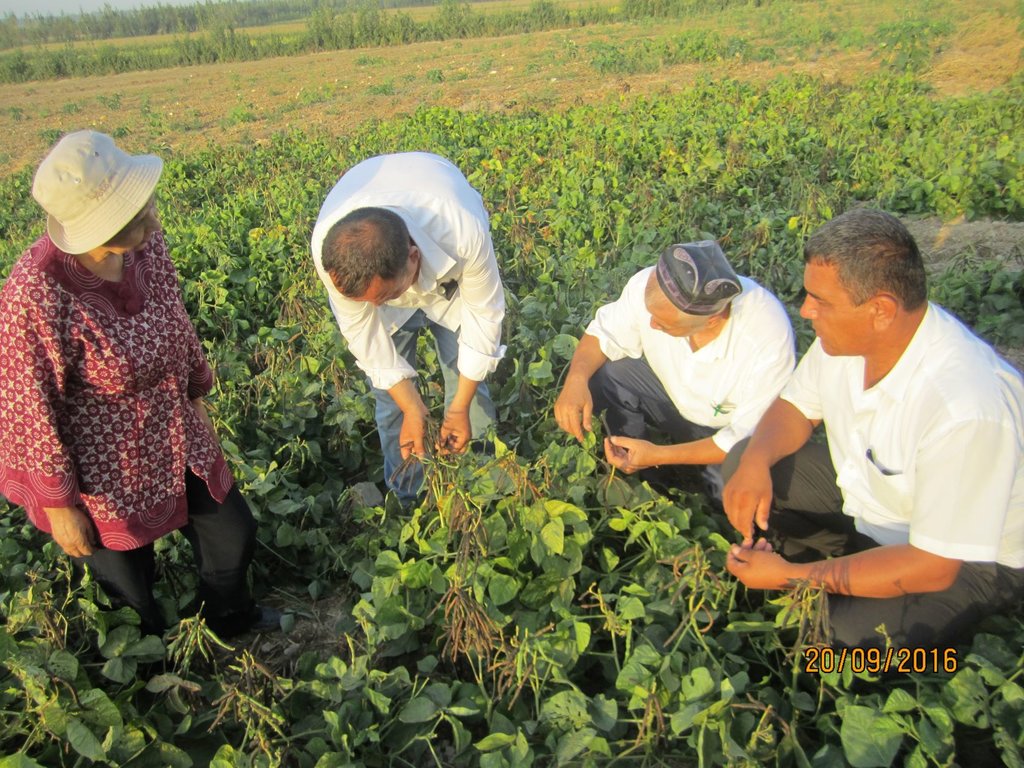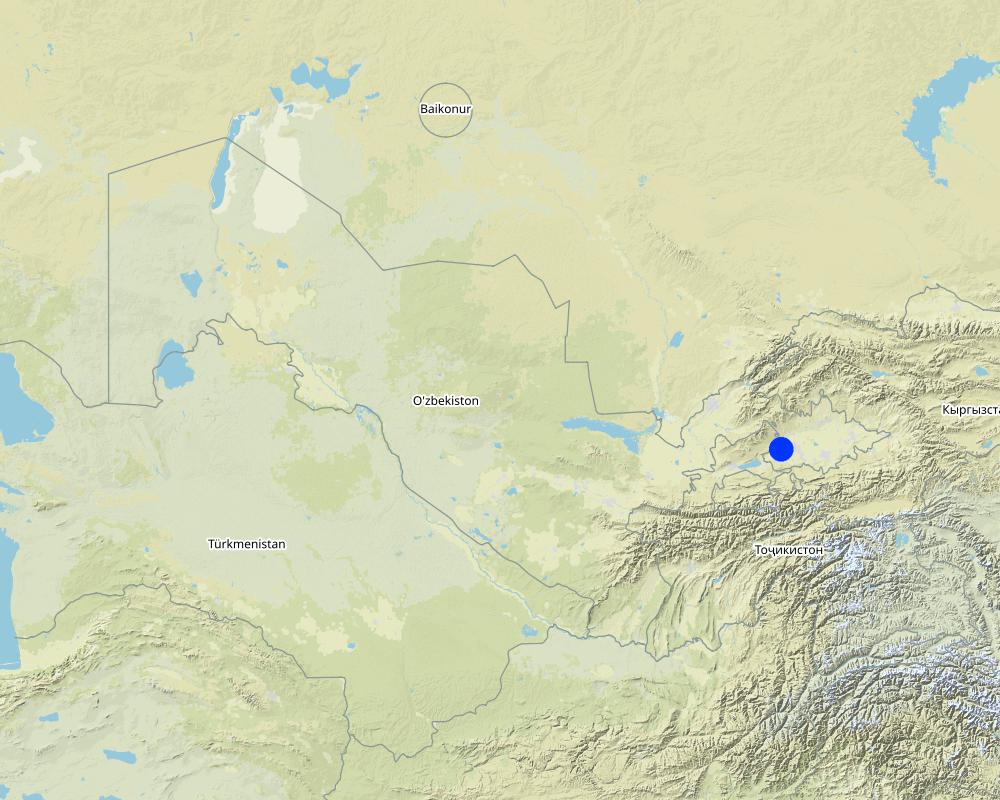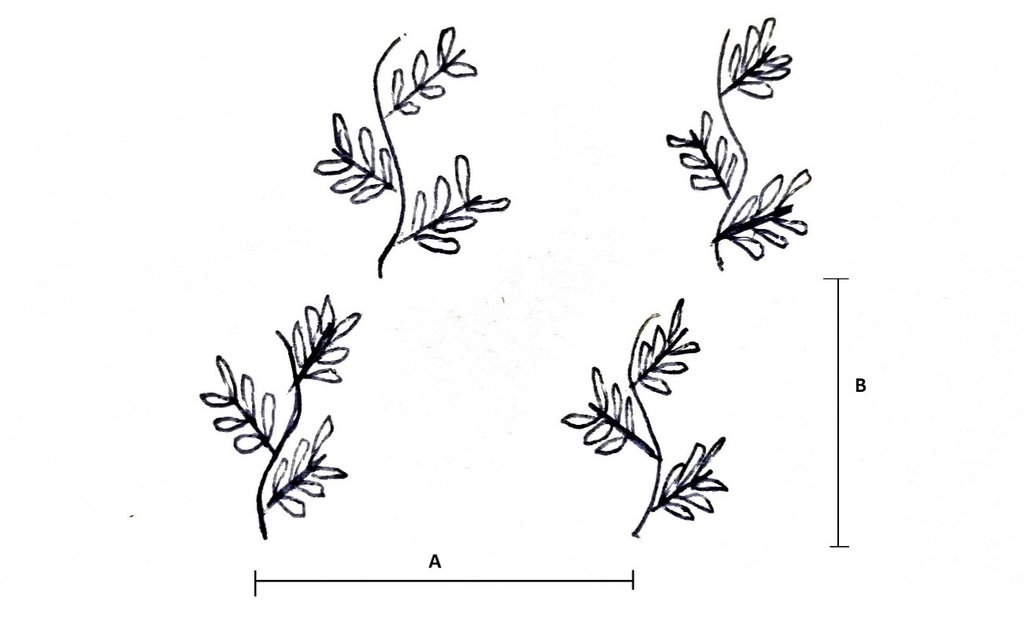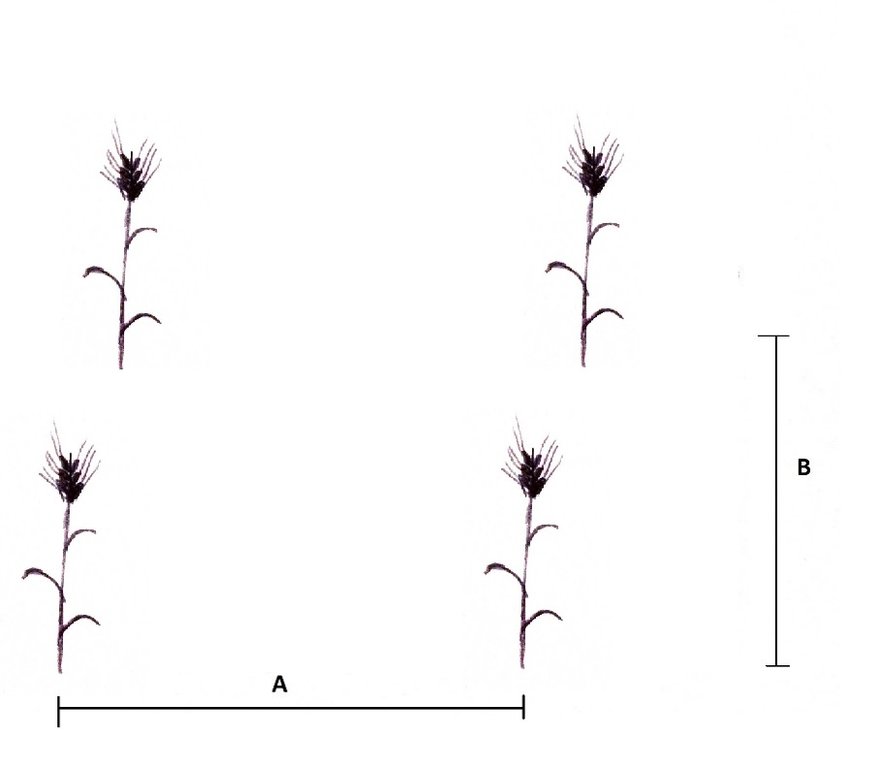Winter Wheat - Mung Bean Production System [乌兹别克斯坦]
- 创建:
- 更新:
- 编制者: Joren Verbist
- 编辑者: –
- 审查者: William Critchley, Rima Mekdaschi Studer
technologies_5995 - 乌兹别克斯坦
查看章节
全部展开 全部收起1. 一般信息
1.2 参与该技术评估和文件编制的资源人员和机构的联系方式
关键资源人
Consultant:
Sharma Ram
International Center of Agriculture Research in the Dry Areas (ICARDA)
尼泊尔
Regional Coordinator:
Mavlyanova Ravza
WorldVeg
乌兹别克斯坦
Field Research Assistant:
Amanov Shukhrat
International Center of Agriculture Research in the Dry Areas (ICARDA)
乌兹别克斯坦
Professor:
Saidov Saidjamol
Tajik Farming Institute
塔吉克斯坦
有助于对技术进行记录/评估的项目名称(如相关)
ICARDA Institutional Knowledge Management Initiative有助于对技术进行记录/评估的机构名称(如相关)
International Center for Agricultural Research in the Dry Areas (ICARDA) - 黎巴嫩1.3 关于使用通过WOCAT记录的数据的条件
编制者和关键资源人员接受有关使用通过WOCAT记录数据的条件。:
是
1.4 所述技术的可持续性声明
这里所描述的技术在土地退化方面是否存在问题,导致无法被认为是一种可持续的土地管理技术?:
否
2. SLM技术的说明
2.1 技术简介
技术定义:
The cultivation of short duration mung bean varieties lead to higher farm-income and improved soil health in Central Asia
2.2 技术的详细说明
说明:
Central Asia is known for its harsh climate, extreme temperature differences and low precipitation. Uzbekistan is no exception to this. Its temperatures vary between -20 and 40 degrees Celsius and precipitation is limited to less than 400 millimetres. This results in difficult conditions for farmers to ensure agricultural production and food security.
Winter wheat is commonly grown to achieve food security and farm income as it is suited to the environment. However, the continuous cultivation of winter wheat has led to severe soil degradation and depletion, through extraction of soil organic matter and soil nutrients. Inevitably, this makes the soil unsuitable for crop cultivation.
The International Centre of Agricultural Research in Dry Areas (ICARDA) anticipated this challenge, and introduced improved mung bean varieties in 2014. Mung bean (or "green gram": Vigna radiata) is a leguminous crop, which replenishes soil organic matter and fertility through nitrogen fixation. By including mung bean in the winter wheat production system, soil health is improved, fallow period reduced, and farmer incomes are increased. The increased farm income is due to the reduced amount of fertilizer required, increased yields and higher selling prices.
Mung bean realizes a profit of roughly 2000 USD per hectare in a period of 100 days, while winter wheat profits are approximately 600 USD per hectare in an eight month period. These numbers show the significant benefit of incorporating mung bean. Scientist have demonstrated that cultivating only mung bean would lead to even higher profit margins, but concluded that adoption is unrealistic as wheat is pre-dominantly grown for food security.
The incorporation of mung bean in the agricultural production system has one downside and that is increased irrigation demand, because mung bean requires additional water.
The mung bean-winter wheat-system follows the following crop rotation. The field for mung bean is tilled and harrowed, prior to seeding. Mung bean is mechanically seeded and manually harvested in June-July and September-October respectively. In this growing period, the field is weeded either manually or by a cultivator, irrigated, fertilizer mechanically applied or hand broadcast and mechanically weeded.
Winter wheat is mechanically planted in October, after the field is harrowed. In March-April, the wheat crops are treated with chemicals and fertilizers. In June-July, the winter wheat is mechanically harvested. Winter wheat also receives irrigation through a canal.
To conclude, this documentation shows that smart ICARDA crop choice with improved varieties extremely benefits local farmers incomes and adds resilience. It also reduces land degradation within a commonly used production system.
Data presented in this work is partly made available through CGIAR Research Program on Dryland Systems; Collaborative Research Project on Sustainable Soil Management to Enhance Agricultural Productivity in Central Asia funded by IFPRI within the framework of Russian Federation funding to CGIAR (2018-2019); CGIAR Collaborative Research & Capacity Building Program for the Development of Sustainable and Resilient Agricultural Production in Central Asia within the framework of Russian Federation Funding (2013-2016).
2.3 技术照片
2.5 已应用该技术的、本评估所涵盖的国家/地区/地点
国家:
乌兹别克斯坦
具体说明该技术的分布:
- 均匀地分布在一个区域
如果不知道精确的区域,请注明大致覆盖的区域:
- 10-100 平方千米
技术现场是否位于永久保护区?:
否
Map
×2.6 实施日期
如果不知道确切的年份,请说明大概的日期:
- 不到10年前(最近)
2.7 技术介绍
详细说明该技术是如何引入的:
- 在实验/研究期间
- 通过项目/外部干预
3. SLM技术的分类
3.1 该技术的主要目的
- 改良生产
- 减少、预防、恢复土地退化
- 创造有益的经济影响
- 创造有益的社会影响
3.2 应用该技术的当前土地利用类型
同一土地单元内混合使用的土地::
否

农田
- 一年一作
年作 - 具体指明作物:
- 谷类 - 小麦(冬季)
- 豆科牧草和豆类 - 豆子
每年的生长季节数:
- 2
采用间作制度了吗?:
否
采用轮作制度了吗?:
是
3.3 由于技术的实施,土地使用是否发生了变化?
由于技术的实施,土地使用是否发生了变化?:
- 否(继续问题3.4)
3.4 供水
该技术所应用土地的供水:
- 混合雨水灌溉
3.5 该技术所属的SLM组
- 改良的地面/植被覆盖
- 改良植物品种/动物品种
3.6 包含该技术的可持续土地管理措施

农艺措施
- A1:植被和土壤覆盖层
- A2:有机质/土壤肥力

管理措施
- M2:改变管理/强度级别
3.7 该技术强调的主要土地退化类型

土壤水蚀
- Wt:表土流失/地表侵蚀
- Wg:冲沟侵蚀/沟蚀

土壤风蚀
- Et:表土流失

化学性土壤退化
- Cn:肥力下降和有机质含量下降(非侵蚀所致)
3.8 防止、减少或恢复土地退化
具体数量名该技术与土地退化有关的目标:
- 防止土地退化
- 减少土地退化
4. 技术规范、实施活动、投入和成本
4.1 该技术的技术图纸
技术规范(与技术图纸相关):
The following dimensions relate to mung bean cultivation:
A = Plant spacing within row = 8 to 10 centimetres
B = Spacing between rows = 45 to 60 centimetres
The plant density is 200,000 to 250,000 plants per hectare.
作者:
Joren Verbist
日期:
28/11/2021
技术规范(与技术图纸相关):
The following dimensions relate to Winter Wheat cultivation:
A = Plant spacing within row = 2 to 4 centimetres
B = Spacing between rows = 15 centimetres
The plant density is 4.5 million to 5 million plants per hectare.
作者:
Joren Verbist
日期:
28/11/2021
4.2 有关投入和成本计算的一般信息
具体说明成本和投入是如何计算的:
- 每个技术区域
注明尺寸和面积单位:
1 Hectare
具体说明成本计算所用货币:
- 美元
4.3 技术建立活动
| 活动 | 时间(季度) | |
|---|---|---|
| 1. | Mung bean: Seed procurement | May-June |
| 2. | Mung bean: Land preparation | June-July |
| 3. | Mung bean: Planting | June-July |
| 4. | Mung bean: Fertilization | June-July |
| 5. | Mung bean: Weed control | August |
| 6. | Mung bean: Harvesting and threshing | September-October |
| 7. | Mung bean: Storage for consumption and marketing | October onward |
| 8. | Wheat: Seed Procurement | August-September |
| 9. | Wheat: Land Preparation | September |
| 10. | Wheat: Seeding | October |
| 11. | Wheat: Fertilizer Application | March-April |
| 12. | Wheat: Weed control | March-April |
| 13. | Wheat: Harvesting and threshing | June-July |
| 14. | Wheat: Storage for consumption and market | July onward |
4.4 技术建立所需要的费用和投入
| 对投入进行具体说明 | 单位 | 数量 | 单位成本 | 每项投入的总成本 | 土地使用者承担的成本% | |
|---|---|---|---|---|---|---|
| 劳动力 | WW: Irrigating | Person-days | 6.0 | 10.0 | 60.0 | 100.0 |
| 劳动力 | MB: Weeding | Person-days | 3.8 | 10.0 | 38.0 | 100.0 |
| 劳动力 | MB: Harvesting | Person-days | 3.8 | 10.0 | 38.0 | 100.0 |
| 劳动力 | MB: Irrigating | Person-days | 2.0 | 10.0 | 20.0 | 100.0 |
| 设备 | MB: Plowing | Machine-Hours | 1.0 | 25.0 | 25.0 | 100.0 |
| 设备 | MB: Tilling & Harrowing | Machine-Hours | 1.0 | 16.0 | 16.0 | 100.0 |
| 设备 | MB: Seeding | Machine-Hours | 1.0 | 20.0 | 20.0 | 100.0 |
| 设备 | MB: Cultivation | Machine-Hours | 3.0 | 15.0 | 45.0 | 100.0 |
| 设备 | WW: Levelling | Machine-Hours | 1.0 | 25.0 | 25.0 | 100.0 |
| 设备 | WW: Seeding | Machine-Hours | 2.0 | 15.0 | 30.0 | 100.0 |
| 设备 | WW: Chemical Spray | Machine-Hours | 3.0 | 5.0 | 15.0 | 100.0 |
| 设备 | WW: Fertilizer Application | Machine-Hours | 4.0 | 5.0 | 20.0 | 100.0 |
| 植物材料 | MB: Seeds | Kilogram | 18.0 | 2.2 | 39.6 | 100.0 |
| 植物材料 | WW: Seeds | Kilogram | 250.0 | 0.45 | 112.5 | 100.0 |
| 肥料和杀菌剂 | MB: Amophos | Kilogram | 200.0 | 0.24 | 48.0 | 100.0 |
| 肥料和杀菌剂 | MB: Urea | Kilogram | 150.0 | 0.23 | 34.5 | 100.0 |
| 肥料和杀菌剂 | WW: Amophos | Kilogram | 300.0 | 0.24 | 72.0 | 100.0 |
| 肥料和杀菌剂 | WW: Urea | Kilogram | 700.0 | 0.23 | 161.0 | 100.0 |
| 肥料和杀菌剂 | WW: Herbicide | Gram | 300.0 | 0.17 | 51.0 | 100.0 |
| 肥料和杀菌剂 | WW: Fungicide | Milliliter | 200.0 | 0.035 | 7.0 | 100.0 |
| 肥料和杀菌剂 | WW: Pesticide | Milliliter | 200.0 | 0.015 | 3.0 | 100.0 |
| 其它 | WW: Threshing | Machine-Hours | 1.0 | 50.0 | 50.0 | 100.0 |
| 其它 | MB: Threshing | Machine-Hours | 2.0 | 35.0 | 70.0 | 100.0 |
| 其它 | MB: Cleaning | Machine-Hours | 1.0 | 25.0 | 25.0 | 100.0 |
| 其它 | Total Fuel Required | Liter | 115.0 | 0.85 | 97.75 | 100.0 |
| 技术建立所需总成本 | 1123.35 | |||||
| 技术建立总成本,美元 | 1123.35 | |||||
注释:
MB relates to Mung bean and WW to Winter Wheat
5. 自然和人文环境
5.1 气候
年降雨量
- < 250毫米
- 251-500毫米
- 501-750毫米
- 751-1,000毫米
- 1,001-1,500毫米
- 1,501-2,000毫米
- 2,001-3,000毫米
- 3,001-4,000毫米
- > 4,000毫米
农业气候带
- 半干旱
5.2 地形
平均坡度:
- 水平(0-2%)
- 缓降(3-5%)
- 平缓(6-10%)
- 滚坡(11-15%)
- 崎岖(16-30%)
- 陡峭(31-60%)
- 非常陡峭(>60%)
地形:
- 高原/平原
- 山脊
- 山坡
- 山地斜坡
- 麓坡
- 谷底
垂直分布带:
- 0-100 m a.s.l.
- 101-500 m a.s.l.
- 501-1,000 m a.s.l.
- 1,001-1,500 m a.s.l.
- 1,501-2,000 m a.s.l.
- 2,001-2,500 m a.s.l.
- 2,501-3,000 m a.s.l.
- 3,001-4,000 m a.s.l.
- > 4,000 m a.s.l.
说明该技术是否专门应用于:
- 不相关
5.3 土壤
平均土层深度:
- 非常浅(0-20厘米)
- 浅(21-50厘米)
- 中等深度(51-80厘米)
- 深(81-120厘米)
- 非常深(> 120厘米)
土壤质地(表土):
- 中粒(壤土、粉土)
土壤质地(地表以下> 20厘米):
- 中粒(壤土、粉土)
表土有机质:
- 中(1-3%)
- 低(<1%)
5.4 水资源可用性和质量
地下水位表:
5-50米
地表水的可用性:
好
水质(未处理):
仅供农业使用(灌溉)
水质请参考::
地下水和地表水
水的盐度有问题吗?:
是
该区域正在发生洪水吗?:
否
5.5 生物多样性
物种多样性:
- 低
栖息地多样性:
- 低
5.6 应用该技术的土地使用者的特征
定栖或游牧:
- 定栖的
生产系统的市场定位:
- 混合(生计/商业)
非农收入:
- 收入的10-50%
相对财富水平:
- 非常贫瘠
- 贫瘠
个人或集体:
- 个人/家庭
机械化水平:
- 机械化/电动
性别:
- 女人
- 男人
土地使用者的年龄:
- 青年人
- 中年人
- 老年人
5.7 应用该技术的土地使用者使用的平均土地面积
- < 0.5 公顷
- 0.5-1 公顷
- 1-2 公顷
- 2-5公顷
- 5-15公顷
- 15-50公顷
- 50-100公顷
- 100-500公顷
- 500-1,000公顷
- 1,000-10,000公顷
- > 10,000公顷
这被认为是小规模、中规模还是大规模的(参照当地实际情况)?:
- 小规模的
5.8 土地所有权、土地使用权和水使用权
土地所有权:
- 个人,有命名
土地使用权:
- 个人
用水权:
- 个人
5.9 进入服务和基础设施的通道
健康:
- 贫瘠
- 适度的
- 好
教育:
- 贫瘠
- 适度的
- 好
技术援助:
- 贫瘠
- 适度的
- 好
就业(例如非农):
- 贫瘠
- 适度的
- 好
市场:
- 贫瘠
- 适度的
- 好
能源:
- 贫瘠
- 适度的
- 好
道路和交通:
- 贫瘠
- 适度的
- 好
饮用水和卫生设施:
- 贫瘠
- 适度的
- 好
金融服务:
- 贫瘠
- 适度的
- 好
6. 影响和结论性说明
6.1 该技术的现场影响
社会经济效应
生产
作物生产
作物质量
收入和成本
农业投入费用
农业收入
收入来源的多样性
社会文化影响
食品安全/自给自足
生态影响
土壤
土壤覆盖层
养分循环/补给
土壤有机物/地下C
生物多样性:植被、动物
植被覆盖
生物量/地上C
6.3 技术对渐变气候以及与气候相关的极端情况/灾害的暴露和敏感性(土地使用者认为的极端情况/灾害)
渐变气候
渐变气候
| 季节 | 增加或减少 | 该技术是如何应对的? | |
|---|---|---|---|
| 年降雨量 | 减少 | 不好 |
6.4 成本效益分析
技术收益与技术建立成本相比如何(从土地使用者的角度看)?
短期回报:
非常积极
长期回报:
非常积极
技术收益与技术维护成本/经常性成本相比如何(从土地使用者的角度看)?
短期回报:
非常积极
长期回报:
非常积极
6.5 技术采用
- > 50%
在所有采用这项技术的人当中,有多少人是自发的,即未获得任何物质奖励/付款?:
- 91-100%
6.6 适应
最近是否对该技术进行了修改以适应不断变化的条件?:
否
6.7 该技术的优点/长处/机会
| 土地使用者眼中的长处/优势/机会 |
|---|
| Significantly increased farm net-income |
| Adds nitrogen to soil and improves organic matter content of soil. |
| Mung bean has higher market price than traditionally grown wheat |
| 编制者或其他关键资源人员认为的长处/优势/机会 |
|---|
| Keeps soil covered during summer and early autumn months, thus protecting soil from heat |
6.8 技术的弱点/缺点/风险及其克服方法
| 土地使用者认为的弱点/缺点/风险 | 如何克服它们? |
|---|---|
| Increased workload for extra crop | The increased net-income justifies this |
| Increased demand for extra water | Efficient irrigation systems |
| 编制者或其他关键资源人员认为的弱点/缺点/风险 | 如何克服它们? |
|---|---|
| Increased demand for irrigation water | Efficient irrigation systems |
7. 参考和链接
7.1 信息的方法/来源
- 与SLM专业人员/专家的访谈
- 根据报告和其他现有文档进行编译
(现场)数据是什么时候汇编的?:
2021
链接和模块
全部展开 全部收起链接
无链接
模块
无模块


